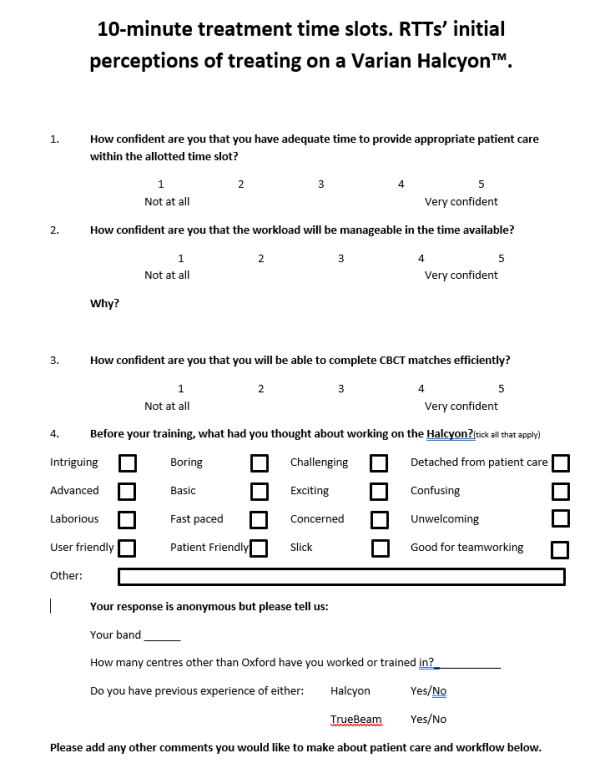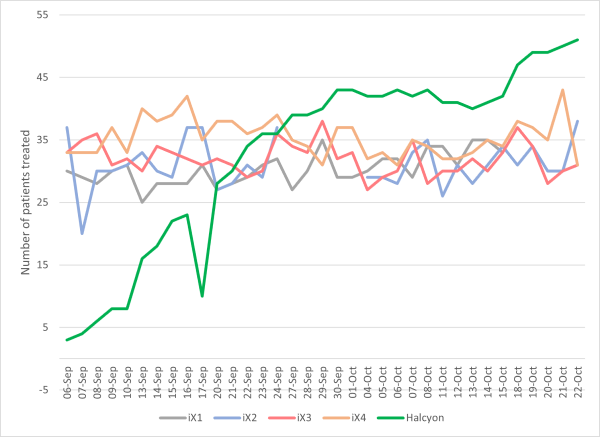10-minute treatment appointments. RTT's initial perceptions of treating on a Varian Halcyon™.
Sarah Ruane,
United Kingdom
PO-1866
Abstract
10-minute treatment appointments. RTT's initial perceptions of treating on a Varian Halcyon™.
Authors: Sarah Ruane1, Tamasin Rees1, Shijo Varghese1, Edyta Olawale1, Louise Drummond1
1Oxford University Hospitals NHS Foundation Trust, Radiotherapy, Oxford, United Kingdom
Show Affiliations
Hide Affiliations
Purpose or Objective
Radiotherapy capacity in the UK is increasingly
under pressure due to historic lack of provision, rising incidence of cancer in
an aging population and technological developments improving and expanding
treatment options. Varian’s Halcyon™ has the potential to increase capacity
through accelerated treatment times and improved workflow but is there an
impact on patient care and staff satisfaction?
Only the 5th Halcyon to go live in the UK, our
local institution became the first UK department to adopt a 10-minute
appointment time from the start of clinical use, utilising a structured
framework to facilitate treating up to 51 patients per day, covering a variety
of treatment sites.
Prior to working on the Halcyon, RTTs expressed
concerns that patient care could deteriorate and staff become overstretched
from the rapid throughput. They were also worried that the perceived simplicity
of operating the new linac would lead to deskilling of RTTs.
To maintain the quality of patient care and staff
wellbeing on Halcyon, it was important to look at these concerns.
Material and Methods
A questionnaire was used to ascertain RTTs’
confidence levels in maintaining patient care, managing workflow and their own
skill levels before having their training on Halcyon. They were also asked to
indicate which feelings or descriptions they felt were relevant. The same
questions were then asked at the end of a single day’s experience. This looked
to understand their perceptions of starting to treat patients on Halcyon and
how these views changed with experience.

A timing audit facilitated understanding of linac
workflow. Consideration was made for patients who had severe mobility issues,
pacemakers or other significant needs.
The numbers of patients treated each day on all
linacs in the department were reviewed in the run up to full capacity on
Halcyon to understand implications of integrating new equipment but also to
quantify the impact on capacity in a busy department.
Results
Confidence levels increased for all topics surveyed.
This was across all staff surveyed regardless of staff skill level.
Average
time in room per patients was 10:22mins (range 11:09-09:19).
Patient numbers treated
on Halcyon exceeded those on other linacs (iX) from the start of 4th week of
operation with up to 51patients treated per day. This represents an absolute
increase in number of patients treated per day on other linacs over the same
period, which treated an average of 32 patients per day (range 28.5-35.3).

Conclusion
After a minimum of 1 day on Halcyon, radiographers
advised increased confidence levels in achieving timings and maintaining
patient care levels. They also showed increased confidence in matching CBCTs,
with the greatest rise seen in newly qualified
radiographers.
While treating more patients than any other linac,
in-room times under 11 mins per patient were routinely achieved. The structure
of the day was very important and including hourly 10 min catch up bookings
facilitated a smooth workflow.